Check out our range of stock.
Didn't find what you like?
Send us a message
Found something out of stock?
Send us a message

Bioscape Ammonia Extraction Pad Bioscape is an Australian aquatic brand concentrating on quality aquarium accessories with an emphasis on aquascaping. Every Bioscape Aquarium or Cloud tank is handcrafted with care and given to the consumer with a personalised signed card by the person who proudly built it. All tank care products are designed using premium materials to make fish and reptile care extra convenient, fun, and full of wonder. This durable polyfiber pad is impregnated with an ammonia-absorbing resin to reduce the levels of ammonia in your aquarium and prevent ammonia burn and other stress. This product is ideal for increasing water quality and improving fish health by controlling ammonia. Ammonia levels are caused by decaying organic matter, overfeeding and overcrowding. Bioscape Tropic Filter Pads can be cut to fit almost any filtration application including power filters, trickle filters, wet-dry filters, power heads, canister filters, pond filters and other mechanical filter applications. They work efficiently to create clear and healthy water conditions, helping to improve the quality of life of your fishies. Durable polyfibre pad impregnated with resin Reduce the levels of ammonia Improves water quailty and fish health Can be cut to fit any filtration system Measurements: The large cut to size filter pads measure 254mm x 457mm. They are suitable for fresh or saltwater applications.
$9.95

Bioscape Carbon Extraction Pad Bioscape is an Australian aquatic brand concentrating on quality aquarium accessories with an emphasis on aquascaping. Every Bioscape Aquarium or Cloud tank is handcrafted with care and given to the consumer with a personalised signed card by the person who proudly built it. All tank care products are designed using premium materials to make fish and reptile care extra convenient, fun, and full of wonder. This durable polyfiber pad is impregnated with activated carbon to remove water discolouration, odours, residual medications, toxins, pollutants and dissolved fish waste. By doing this, it increases water quality and clarity, and improves fish health by reducing the amount of common aquarium pollutants. Bioscape Tropic Filter Pads can be cut to fit almost any filtration application, including power filters, trickle filters, wet-dry filters, power heads, canister filters, pond filters and other mechanical filter applications. Durable polyfibre pad impregnated with activated carbon Reduces the levels of toxins, pollutants and residues Improves water quailty and fish health Can be cut to fit any filtration system Measurements: The large cut to size filter pads measure 254mm x 457mm. They are suitable for fresh or saltwater applications.
$9.95

Bioscape Moss Matting is a uniquely designed synthetic matting that can be used wherever moisture needs to be retained to enable or encourage plant growth. Its ability to both 'wick' and hold moisture makes it a useful tool in terrariums and when mounting certain plants. The woven structure is suited to promote root growth. Holds moisture while at the same time allows air circulation around the roots. Can be easily attached to vertical surfaces with plant friendly adhesives such asacetic cure silicon or hot glue. Material can wick water to heights of 45-60cm ensuring delicate mosses are kept hydrated at all times.
$12.95

Bioscape is an Australian aquatic brand concentrating on quality aquarium accessories with an emphasis on aqua scaping. Every Bioscape Aquarium or Cloud tank is handcrafted with care and given to the consumer with a personalized signed card by the person who proudly built it. All tank care products are designed using premium materials to make fish and reptile care extra convenient fun and full of wonder. Air pump 2000 model suitable for tanks Energy efficient motor Ultra quiet operation Powerful and reliable For fresh and marine water aquariums Bonus check valves for each outlet
$20.00

Welcome the beauty of the Black Angel into your home! This exquisite fish boasts vibrant black scales and a graceful, flowing tail that will be sure to spark admiration. Add a touch of natural elegance to your aquarium with the majestic Black Veiltail Angel!
$10.00

The Black Bio Filter Sponge is a 45x45x2cm sheet of filter sponge made from durable and high-quality materials such as polyester and non-woven fabrics. This filter sponge is designed to trap dirt, debris and other particles in an aquarium. It is easy to install and maintain, and it is also effective in removing unwanted particles from the water. The filter sponge is also able to retain beneficial bacteria, thus creating a healthy aquatic environment. The Black Bio Filter Sponge is suitable for both freshwater and saltwater tanks, and it is an ideal choice for aquariums of all sizes.
$20.00

This black bio filter sponge measures 45x45x4.5 cm and is designed to effectively filter out debris and other particles from the water. It is made from a durable and highly absorbent material that traps dirt and debris, while the porous structure allows water to easily flow through. The sponge is also ideal for providing a safe and healthy environment for aquatic life, as it helps to reduce nitrate levels and improve water quality. The filter sponge is easy to clean and maintain, and it can be used in both fresh and saltwater aquariums.
$40.00

SPECIAL ORDER ITEM - Please allow 5 days turnaround. The Black Egg Crate 2ft x 4ft Sheet is a high-performance, lightweight, and durable sheet made from a unique hybrid of polypropylene and recycled wood fibers. It is designed to provide superior strength and rigidity, while still being lightweight and easy to transport. Designed with an innovative honeycomb core and a durable, non-slip surface, this sheet is ideal for use as a flooring or countertop material. It is waterproof, stain-resistant, and easy to clean, making it a great choice for any indoor or outdoor project. This sheet is also resistant to UV rays, so it won't fade or discolor over time. With a modern, sleek design, this sheet is sure to make any project look great.
$99.00

The black ghost knifefish (Apteronotus albifrons) is a tropical fish belonging to the ghost knifefish family (Apteronotidae). They originate in freshwater habitats in South America where ranging from Venezuela to the Paraguay–Paraná River, including the Amazon Basin.[1] They are popular in aquaria. The fish is all black except for two white rings on its tail, and a white blaze on its nose, which can occasionally extend into a stripe down its back. It moves mainly by undulating a long fin on its underside. It will grow to a maximum length of 50 cm (20 in). Source: Wikipedia contributors. (2019, October 8). Black ghost knifefish. In Wikipedia, The Free Encyclopedia. Retrieved 01:12, October 19, 2019, from https://en.wikipedia.org/w/index.php?title=Black_ghost_knifefish&oldid=920249449
$25.00

Half-black-guppy males are fish that have a unique look. They are a cross between a black guppy and a regular guppy, resulting in a fish that has a mix of black and regular guppy colors. They typically have a black body with a regular guppy pattern on their tail. Half-black-guppy males are known for their hardiness and colorful appearance, and they can often be seen in aquariums around the world. They are active swimmers and can be kept with other peaceful fish. They are easy to care for and require regular water changes and a high-quality diet to stay healthy.
$10.00

General care for shrimp: Temperature:18°-24°C Chlorine/chloramines: 0 ppm (very toxic for shrimp) Ammonia/Nitrite: 0 ppm. Nitrate: <20 ppm. pH: 6.2-7.5. GH: 4-8 dGH KH: 3-15 dKH Name Optimal TDS Limits Cherry shrimp 150 – 200 100 – 400 Cardinal shrimp 100 50 – 150 Tiger shrimp 180 – 220 100 – 300 We strongly recommend to drip acclimate any shrimp untill the TDS matches before you release the shrimp into your tank. Please note the above is just a general indication of the care requirements of shrimp. Results will vary depending on the individuals set up. NO SHIPPING TO WA
$25.00 - $30.00

The Black Kuhli Loach is a unique and attractive fish that is native to Southeast Asia. It is a small fish, typically reaching about 7 cm (2.7 inches) in length when fully grown. It has an elongated, eel-like body with a black coloration that is accented by yellow stripes running down its sides. The Black Kuhli Loach is an active and peaceful fish that makes an excellent addition to a community tank. It is an excellent scavenger and is known to help keep the substrate clean by consuming any uneaten food that has sunk to the bottom. It is also an adept hunter, preying on small crustaceans, worms, and insects.
$10.00
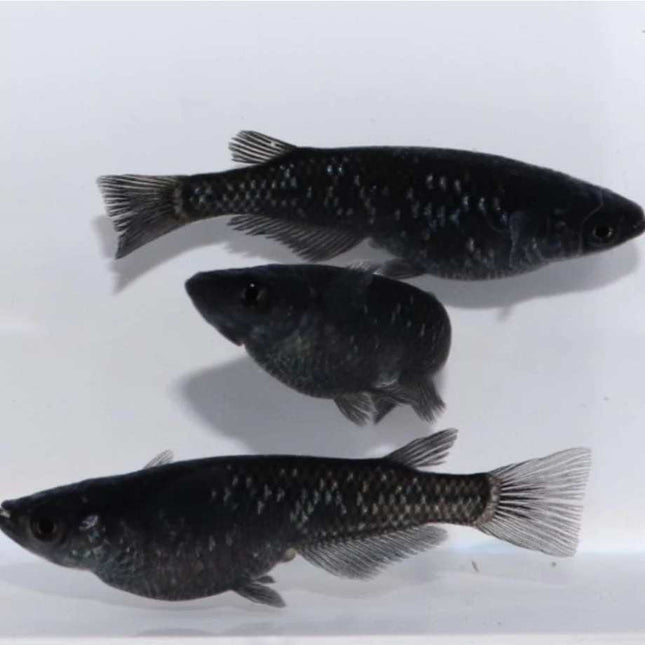
Introducing the Black Medaka Rice Fish, a rare and distinctive fish that will make a beautiful addition to any aquarium. These fish are 3-4cm in size and feature a striking black hue, adding a unique touch to your aquatic display. Enjoy the unique beauty of this rare fish!
$19.00 $15.00
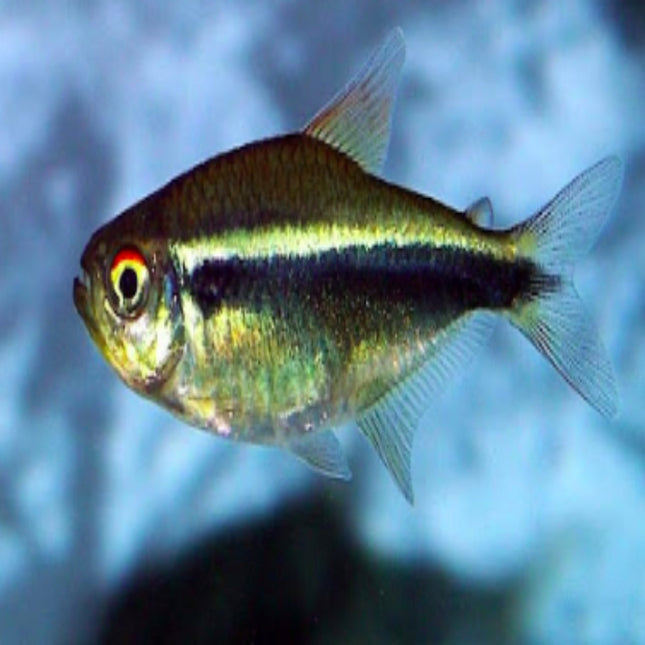
COMMON NAMES: Black tetra, neon tetra, black neonSCIENTIFIC NAME: Hyphessobrycon herbertaxelrodiADULT SIZE: 1.5 inchesLIFE EXPECTANCY: 5 yearsCharacteristicsFamily CharacidaeOrigin BrazilSocial Peaceful, schooling fishTank Level Mid to top-dwellingMinimum Tank Size 10 gallonDiet OmnivoreBreeding EgglayerCare EasypH 5.5 to 7.5Hardness Up to 6 dGHTemperature 73 to 81 F (23 to 27 C)
$3.95

The Black Neon Tetra (Gold Form) is a 3 cm long fish that is native to South America. It has a black body with yellow stripes along its sides and a luminous neon blue stripe running along its back. It has a gold coloration on its fins, giving it a striking appearance. This fish is very active and is a great addition to any tank. It is easy to care for and does well in a variety of water conditions. It is also a very peaceful fish that can be kept with other fish of similar size.
$4.29

The Bleeding Heart Tetra (Hyphessobrycon erythrostigma) is a peaceful, schooling fish that is popular among aquarists. It has a bright pinkish-red body with a black spot at the base of the tail and a white edging around the fins. The body is slender and graceful, with a maximum size of 3-5 cm in length. The Bleeding Heart Tetra is a peaceful fish that does best when kept in groups of 6 or more. It is an omnivore that will feed on a variety of small invertebrates, flakes, and freeze-dried foods. The Bleeding Heart Tetra is a great addition to any peaceful community aquarium and will add color and activity to the tank.
$39.00

Blonde Cobra Guppy, also known as Blonde Snakeskin Guppy, is a popular freshwater fish known for its attractive coloration and striking patterns. These guppies are usually small in size, measuring around 1.5 inches in length, and have a vibrant yellow or blonde base color with bold black stripes, spots or patches that resemble a snake's skin. The males have a distinctive gonopodium, which is used to inseminate the females during breeding. The Blonde Cobra Guppy is a peaceful and easy-to-care-for fish that can be kept in a community aquarium with other peaceful species. They prefer a well-planted tank with plenty of hiding places and subdued lighting. These guppies are omnivorous and require a varied diet that includes high-quality flakes, pellets, and frozen or live foods. With proper care, they can live for around 2 to 3 years.
$10.00

Blonde Tyrone Guppy is an exotic fish known for its bright yellow-orange color and unique body shape. It has a long, slender body with a rounded head and a large tail fin. Its fins are yellow-orange and its scales are a metallic silver. Its eyes are black and its lips are often a deep red color. It is a peaceful fish that prefers to live in groups of other guppies and can often be found swimming in the middle of the tank. It is a very active fish and will happily accept a variety of food. It can be a great addition to any tank, as it is easy to care for and adds a splash of color to its surroundings.
$10.00
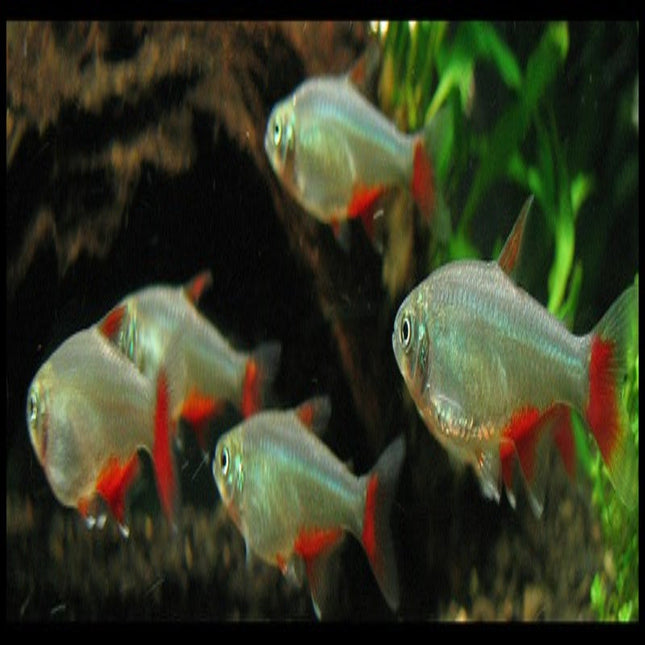
Species Summary Bloodfin Tetras (Aphyocharax anisitsi) are a visually striking freshwater fish that are fun to watch and easy to care for. They are part of the characin family and share many of the same characteristics of other Tetras. These fish are endemic to rivers in South America. They are most commonly found in the Parańa River basin. However, they’ve also been spotted throughout the Amazon, in Eastern Peru, and Colombia. Today, you’re most likely to see these fish as part of a colorful community tank. Bloodfin Tetras do well in large groups and get along with most other peaceful fish. No matter how large your community tank is, these fish are sure to be stars of the show. Lifespan The typical Bloodfin Tetra lifespan is around 5 to 8 years in captivity. This is on-par with many other popular tetra species. Of course, there are no guarantees. Despite their hardiness, these fish can be sensitive to poor water conditions. They need a well-maintained habitat and plenty of high-quality food to truly thrive. Otherwise, their lifespan might be shortened significantly due to disease or injury. Appearance While Bloodfin Tetras may not have the flowing fins or unique body shape as some other aquarium fish, they are certainly quite beautiful in their own right. These are smaller fish that take on a torpedo-like shape. They are girthier towards their head and midsection. However, their shape tapers off to meet their sizable caudal fin. The primary colour of the fish is silver. The scales take on a somewhat iridescent finish. As a result, you may notice flashes of greenish-blue as light bounces off their body. The silvery colour covers most of their mass. Size The size of a full-grown Bloodfin Tetra is just over 2 inches in length. Thanks to their small size, they are very manageable and do well in small to medium-sized tanks. Water Parameters The great thing about Bloodfin Tetras is that they aren’t particularly fussy when it comes to water parameters. They adapt well and won’t have too many issues with slight fluctuations. That said, you still need to stick to a general range of water parameters. Like any fish, Bloodfin Tetras do best in waters that are similar to their natural habitat. This species comes from bodies of water in South America. They prefer things to be on the warmer side (they can survive in colder tanks as well though) with a relatively neutral pH balance. Here are some parameters to follow: Water temperature: 64°F to 82°F (around 70 degrees is preferred) pH levels: 6.0 to 8.0 Water hardness: 2 to 3 dGH As long as you stick within these ranges, your fish should have no problem staying healthy. However, it’s important to test these levels on a consistent basis to make sure they’re stable. Reference https://www.aquariumsource.com/bloodfin-tetra/
$10.00

Blue Clown Pinoy Angels (Pterophyllum) These Blue Clown Pinoy Angels are a variety of Pterophyllum scalare, which originated from the Amazon Basin, Orinoco Basin and various rivers in the Guiana Shield in tropical South America and are thus freshwater fish. Angelfish distinguish themselves from other cichlids in that they are strong laterally compressed, yet have a round body and elongated triangular dorsal and anal fins. These elegant yet strikingly shaped fish are popular with both beginner and experienced aquarists alike, and are a joy to observe. When buying Angels for breeding purposes, it is recommended to buy a group of 6 and let them pair off naturally. Once a pair is formed either move them to a breeding tank or sell off the others. Temperature: 24 – 28°C pH: 6.5 – 7.8 Lifespan: 10+ years Size: 10cm + Diet: Omnivore
$30.00 - $35.00

Blue Cobra Guppies (Poecillia Reticulata) Our Blue Cobra Guppies are Imported, they are all mixed genetics and offer a range of colours, Cobra Guppies get the name from the patterning across the body which resembles a snakeskin like pattern.When buying Guppies we recommend either going all males or a ratio of 1 male to 2 females or more. this is to ensure the females are not getting too stressed out by the males who will constantly chase them wanting to breed. Temperature: 24 – 28°C pH: 6.5 – 7.8 Hardness: 8-12 dGH Lifespan: 2+ years Size: 3.5cm Diet: Omnivore
$8.00 - $10.00
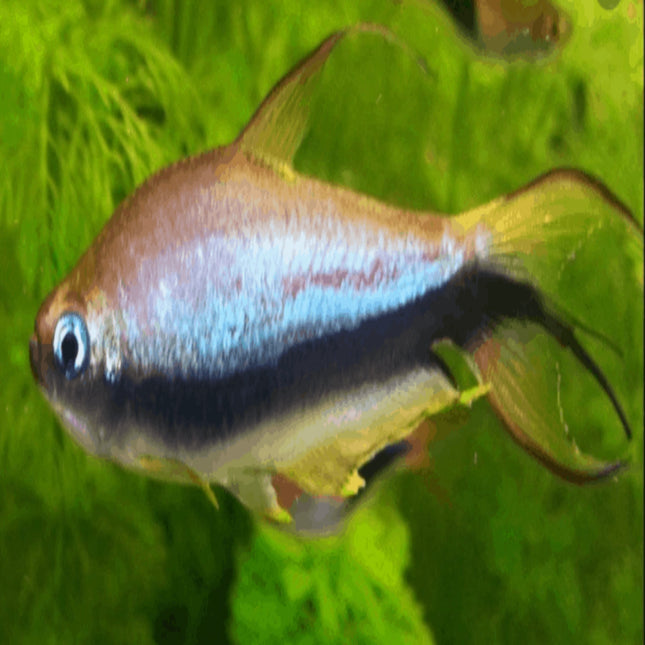
The Emperor Tetra (Nematobrycon palmeri) is a small freshwater fish native to the Pacific slopes of Panama and Colombia. It is a popular aquarium fish due to its beautiful blue, red and silver coloration. The body of the Emperor Tetra is long and slender, with a pointed snout and a forked tail. It usually grows to just over an inch in length, and can live for up to 5 years in captivity. The Emperor Tetra is a peaceful fish that does best in a community tank with other small, peaceful species. It is an omnivore and will feed on a variety of flake and frozen foods.
$8.00

The Blue Grass Guppies was first imported into Australia in 2017 and they were popular at the onset. They are different from the cobra guppies as the black dots that is evident on there caudal (tail) fin is finer and it looks like pepper. The females looks very similar to the males and evident with the small pepper on it as well. A stunning and still a rare species to have in Australia. This is a very sensitive strain where they can get Columnaris very easily, we recommend that you use API Aquarium Salt and API Melafix THE FIRST 3 DAYS IS CRITICAL FOR THIS STRAIN. The second picture is a google image. We take pride on delivering only quality stocks. We will pick a random fish for your order. If you are looking for more tailored picks then consider paying a dedicated team member which will assist you on the video and and get the exact fish you want. You can use the following product for this purpose CLICK HERE
$15.00 - $37.00

The Blue-Headed Apricot Paradise Fish is a stunning species of freshwater fish native to the Mekong and Chao Phraya river basins in Southeast Asia. It has a stunning orange body with a deep blue head, and its fins are adorned with a fiery orange and yellow coloration. This species can reach a maximum size of around 6 inches, making it an ideal size for aquariums. It is a peaceful species that can be kept in community tanks with other peaceful fish. This species loves to feed on a variety of foods, including flakes, frozen, and live. The Blue-Headed Apricot Paradise Fish is an attractive species that will add a splash of color to any aquarium.
$10.00
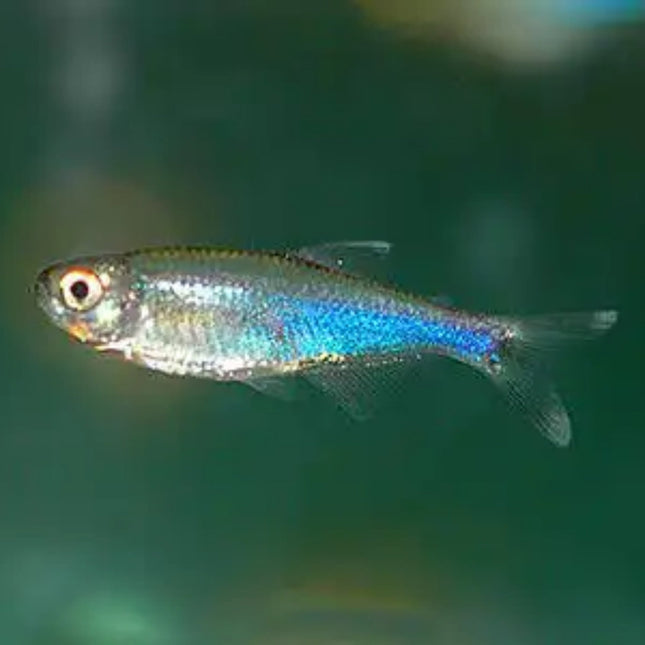
The Blue King Tetra Cochus is a beautiful, freshwater fish with a vibrant blue body and orange fins. This fish is a member of the Characidae family and is native to South America. It has a long, slender body that can reach up to 4 cm in length when fully grown. The Blue King Tetra is a peaceful fish and is best kept in a community tank with other peaceful species. This fish is easy to care for and will thrive in a tank with plenty of plants and hiding places. It is an omnivore, so it will also enjoy a variety of different foods.
$11.95

The Blue Neon Guppy, also known as the Millions Fish, is a popular freshwater aquarium fish that belongs to the Poeciliidae family. These small, active fish are native to South America and have been selectively bred to display striking shades of blue, making them a popular choice for aquarists. Appearance Blue Neon Guppies have elongated, slender bodies with a pointed head and a fan-shaped tail fin. Their coloring is primarily blue, with males exhibiting brighter and more vibrant hues than females. The male Blue Neon Guppy's tail fin is also more elongated and vibrant, while the female's tail fin is shorter and more rounded. Tank Requirements Blue Neon Guppies are hardy and adaptable, making them ideal for beginners. They prefer well-oxygenated water with a temperature range of 72-82°F and a pH range of 7.0-8.0. A 10-gallon aquarium is sufficient for a small school of 6-8 fish. Adding plants and decorations to the tank will provide hiding spots and create a natural environment. Regular water changes and filtration are necessary to maintain optimal water quality. Feeding Blue Neon Guppies are omnivores and will eat a variety of foods, including flakes, pellets, and live or frozen foods such as brine shrimp or daphnia. It is important not to overfeed them, as excess food can lead to poor water quality and health problems. Breeding Blue Neon Guppies are livebearers, meaning that they give birth to live young rather than laying eggs. Males are known for their elaborate courtship displays, which involve showing off their vibrant colors to attract females. Once the eggs have been fertilized, gestation takes around 21-30 days, and the female will give birth to a brood of fry. It is important to separate the fry from the adults, as adult fish may eat them. Conclusion The Blue Neon Guppy is a beautiful and popular freshwater aquarium fish that is easy to care for and breed. Its striking blue coloration and active nature make it an attractive addition to any aquarium. Proper tank conditions, regular feeding, and attention to water quality are key to ensuring their health and longevity.
$8.00 - $10.00

The Blue Panchax is known from heavily vegetated canals, ditches, ponds, reservoirs, and lowland wetlands. It is not unknown for them to move into slightly brackish waters in mangrove creeks, and they thrive on eating the mosquito larvae which land on the water’s surface. A pair of these top-dwelling fish require an aquarium 3ft long, and if a larger group (including more males) are to be kept together, a more spacious tank must be provided. The aquarium itself should be aquascaped with plenty of plants, including floating varieties wherever possible. This will give the fish a natural network of hiding places and territories. Tangles of driftwood can also be added to give additional shelter. Blue Panchax are accomplished jumpers, so it is essential that the tank has tight fitting coverslides. These fish are predatory and have surprisingly wide mouths (view them head-on). Therefore they should never be combined with small community fish e.g. Neon Tetras, as these will soon become a snack. Blue Panchax are best maintained with medium sized fish of a peaceful disposition, and which do not occupy the same extreme top level of the aquarium. Interestingly, in their native homelands, this species is referred to as the ‘White Spot’ on account of the bright silver-white mark on top of the head when viewed from abov Feeding These fish require a good variety of meaty frozen foods, as in the wild they are known to take insects and insect larvae from the water’s surface. Bloodworm and white mosquito larvae are preferred, but they will also enjoy vitamin-enriched brineshrimp and daphnia. Breeding A chosen conditioned pair should be acclimatised to a softwater breeding aquarium furnished with large clumps of fine leaved plants and floating plants. Some aquarists prefer to condition the male and female in separate tanks prior to bringing them together in the breeding aquarium. The eggs, which are of quite a large size, will be deposited amongst the plants near the water’s surface. From here it is easy to transfer them to another growing-on tank so that the parent fish do not predate on them (alternatively, carefully remove the parent fish from this aquarium once spawning has ceased). The eggs usually number between 100 and 150, but up to 250 have been reported from one spawning. These eggs can be expected to hatch within 11-14 days (temperature dependant) and the young offered finely powdered ‘first foods’ and newly hatched brineshrimp. Common Name – Blue Killie Panchax Origin – Western Africa Diet – carnivorous PH Range – 4 – 7 Temperature – Tropical 26°c – 28°c Breed Type – Egg Layer Maximum Size – approximately 9cm Sex – Un-sexed
$10.00

The Blue Paradise Fish is a beautiful and vibrant species of fish native to Southeast Asia. It is a hardy fish that grows to a maximum size of 7 centimeters. The male of the species has a stunning iridescent blue body and bright red fins. It is an active and energetic fish that is well suited for tropical community aquariums. It prefers a densely planted aquarium with plenty of hiding places and a sandy substrate. It is best kept in groups of at least three or more, with one male and multiple females. The Blue Paradise Fish is an excellent addition to any freshwater aquarium.
$20.00
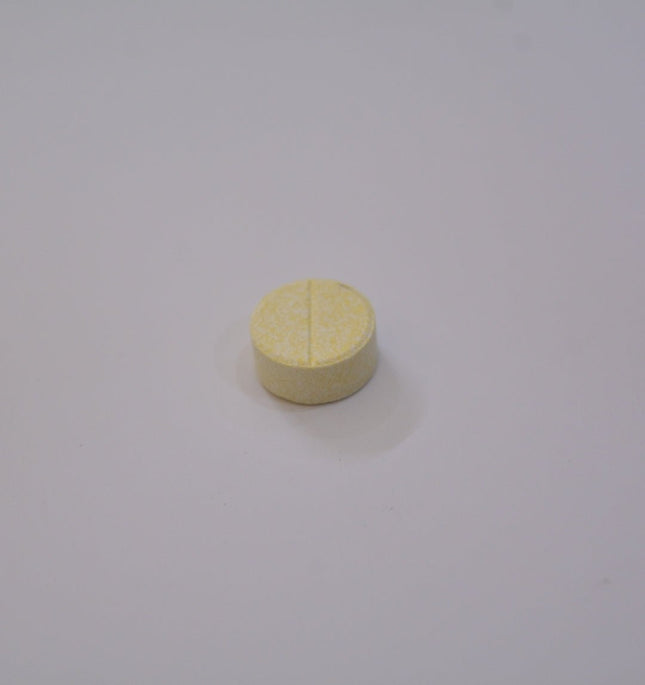
Aquari-Cycline is a broad spectrum Antibiotic in tablet form effective against a wide range of bacterial infections in fresh and saltwater aquariums. Aquari-Cycline tablets are formulated specifically for aquarium use with inert carriers which dissolve rapidly upon contact with water. The active constituent of Aquari-Cycline is "Tetracycline Hydrochloride".Bacterial diseases can be devastating in aquariums and rank along with other water quality problems and protozoa as major causes of loss of aquarium fish. Aquari-Cycline is active against a wide range of Grampositive and Gram-negative bacteria including Aeromomas and Pseudomonas sp. At the recommended dose rate Aquari-Cycline is bacteriostatic against Bacterial Septicaemia, Coldwater Disease, Columnaris Disease (mouth fungus, cottonwool disease), Furunculosis, Fin and Tail Rot.Treatment at the recommended dose rate for three days with subsequent partial water changes has not effected nitrification. However prolonged treatment of mature aquariums with antibiotics will affect nitrifying bacteria. The use of a separate treatment tank is recommended where only a few fish are infected.Dose Rate: 1 tablet per 20L Aquarium waterEach tablet contains 375mg Tetracycline.PACK SIZES: 1 tablet, 25 tablets, 100 tablets
$1.00 - $99.00

This 8 Litre glass aquarium from Blue Planet features a sleek black hood, inbuilt 3 stage filter, energy efficient high powered LED lighting and a 25 W heater. Some amazing features Quick and simple set-up Rimless design (1): 100% eliminates water & salt marks at the rim area - meaning less maintenance for you. Maximum opening (2): Easy removal of the filter box & pump allowing you complete freedom to decorate your aquarium. LED lights (3) with USB plug, colour lens and adaptor is included Built-in Professional 3 stage tank top filtration (4): Great water circulation, easy and convenient maintenance without disturbing your fish and aquarium water. Comes with easy change cartridge (5), besides the usual filter wool, activated carbon & bio rings, it also comes with Zeolite, a substance that removes ammonia (present in your tank as uneaten food and fish waste). A silencer (6) is included for “silent mode”, which reduce noise from water circulation. Tank sealed with premium German silicone with superior UV & weather resistance properties. 1 year limited warranty (wear & tear parts not included) Dimensions: 29 L x 15.5 W x 28.5 H cm
$120.00
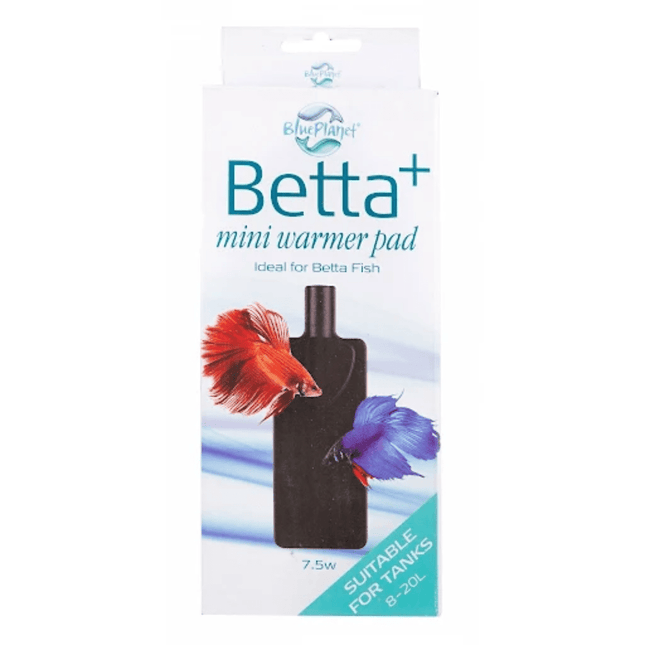
The Blue Planet Mini Warmer pad, is designed specifically to suit small aquariums between 8-20L. It will warm water to around 24C, dependent on the ambient room temperature. DO NOT PLACE directly onto glass or acrylic, near plants or other items that are sensitive to heat Must be fully submerged, before turning on. Can be placed under the gravel or hidden as required. Ensure it has a layer of gravel between the glass. Use the suction cup to keep off the side walls as required. Change 10-15% of tank water weekly. Always add Seachem Prime Suitable for both marine and fresh water tanks. Good for both fresh and marine water. Fully sealed, can be used submersible. Compact size, easy to put into any place in the tank. Great for nano tanks such as betta tanks Suitable for tanks 8-20L Size: 107mm x 50mm
$15.00 - $29.00

Blue Planet's Bubbilo bubble stones filter tens of thousands of minute oxygen bubbles into your aquarium water every hour. These essential bubbles refresh the water, improve water circulation and help evenly distribute heat in tropical tanks - all improving fish health. The bubble stone should sit on the aquarium floor so that the oxygenation, circulation and distribution are maximised. Place your bubble stone near the aquarium heater in tropical tanks to ensure smooth, even temperatures throughout the aquarium. Voltage: 220-240v Frequency: 50-60Hz Power: 4.0v Air Flow: 4.5L/min Pressure: >= 0.014Mpa For tanks 90-120cm/ multiple applications
$59.95
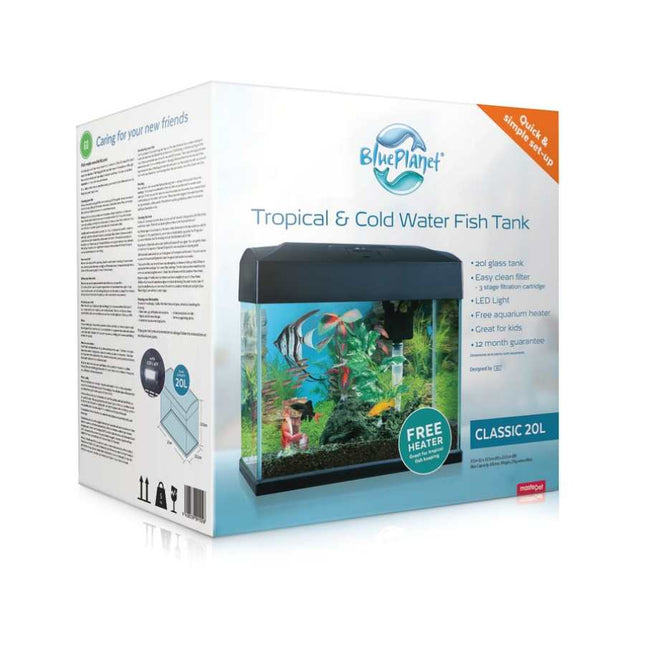
The Blue Planet Classic Aquarium 20 Litre is a premium tank designed to provide aquatic pets with everything they need. This starter pack includes a 20 litre capacity aquarium complete with hood lid, a fully pressurised 3-stage filter to help maintain and clean the tank, and a built-in water pump to help you provide your pet fish and reptiles with a safe, clean, and habitable environment to enjoy. The key features of the Blue Planet Classic Aquarium 20 Litres are: High-quality aquarium suitable for a variety of fish and reptiles. Includes 20 litre tank, lid, filter, water pump, adjustable flow regulator, and LED lamp. Quick and easy set-up is ideal for new starters. Can be used for cold water and tropical fish as well as fresh and saltwater fish. Includes adjustable flow regulator to allow you to adjust water rate to suit different species of fish. Optional heater included. Filter box includes wool, charcoal, and bio-balls. Hood lid allows easy access to the tank for stress-free cleaning. Provides aquatic life with a comfortable and perfectly balanced environment in which to thrive. 5-watt LED lighting system to stimulate natural plant and coral growth. Low consumption wattage minimises running costs and helps the environment. Can provide up to 2 years-worth of power running at 24 hours a day. Water capacity of 20 litres. Pump capacity of 200L/hour. Dimensions: 37cm L x 33.5cm W x 25cm H. Blue Planet products are distributed by Masterpet, a company with over 50 years of experience. Created on the belief that life is just better with a pet, they strive to develop specific products for the specific needs of pet owners. Their products are always known for their quality and reliability.
$199.00
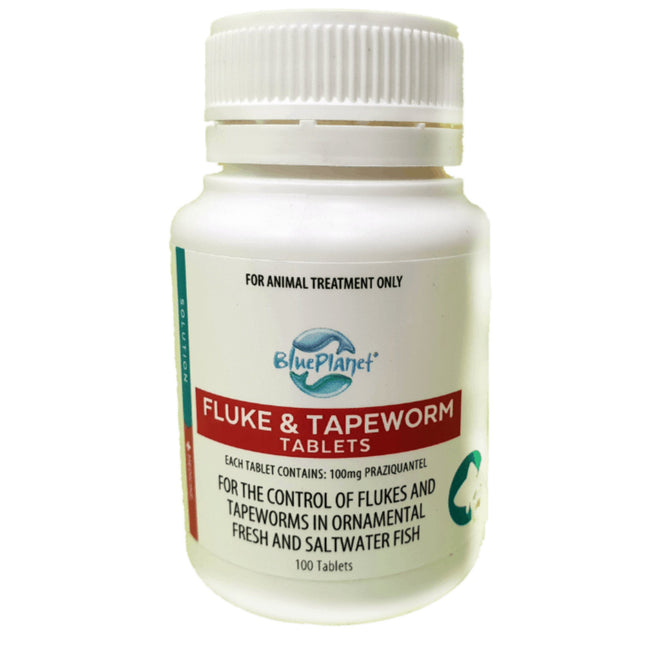
For the control of fluke and tapeworms in ornamental freshwater and saltwater fish. Blue Planet Fluke and Tapeworm tablets have been developed specifically for use in aquariums, formulated with inert excipients to prevent pollution of aquariums. These tablets dissolve rapidly, releasing 95% of the active ingredient (praziquantel) within 10 minutes of application. Praziquintel has been knwon to effectively control fluke and tapeworm in ornamental fish for a number of years. Fluke: a common parasite in freshwater and marine aquariums. Many hundred species are known , the most common groups being Dactylogyrids (parasitising gills) and Gyrodactylids (parasitising gills, skin and fins). Dactylogyrids more commonly known as Gill Flukes, commonly infest all species of ornamental freshwater fish – particularily livebearers, Goldfish, Discus and Angelfish. Fish will show signs of respiratory distress, rapid gill movement, hanging at the surface, small red spots and scraping on objects to relieve irrations. Emaciation, inactivity and colour changes occur in chronic sufferers. Tapeworm: When present, they are found in the intestines, attached to the intestinal wall. Signs of infestation include enlarged abdomen and ill thrift. Do not use on fish intended for human consumption. Remove activated carbon from filtration system for best results. Use 1 tablet per 20L of water. Dissolve tablet first in a cup of aquarium water and the add to aquarium. After 48 hours of initial treatment, change 25% of water and clean filter media. Repeat dose rate after 7 days to prevent re-infestation. Do not overdose. If condition does not improve, consult your veterinarian. Warning: Use with caution when treating aquariums containing snails and catfish.
$32.95 - $99.95

Blue Planet Fungus Cure is an effective treatment for fungal diseases in freshwater and tropical freshwater aquarium fish and will not affect aquarium plants and fish when used at the recommended dose rate.Fungal diseases are common in freshwater fish and are recognised by white or grey threads on the skin or fins which may thicken until they resemble tufts of cotton wool (pin head size) on the fish's body and fins. Unless prompt action is taken fatalities will occur.DIRECTIONS FOR USE: A partial water change (25% of capacity) is recommended before commencing treatment and every third day thereafter before re-treatment until cure is affected. Ensure aquarium water is well aerated and remove activated carbon from filtration system for the duration of treatment. Activated carbon will remove this product form aquarium water resulting in ineffective treatment. DOSE RATES: Use 0.25mL (5 drops) per 1 litre or use at the rate of 5mL per 20 litres of aquarium water. For Tetra species, baby fish and scaleless fish (Loaches, etc) use at a rate of 5ml per 40 litres of aquarium water. DO NOT OVERDOSE. Repeat treatment after 3 days Contains: 2.00mg/mL Acriflavine, 0.40mg/mL Malachite Green.This product contains a dye product which will stain if spilled.SIZES:50mL125mL500mL
$9.95 - $19.95

Active Ingredients:2.00mg/mL Acriflavine0.40mg/mL Malachite Green Fungal diseases are common in freshwater fish and are identified by white or grey threads on the skin or fins which may thicken until they resemble tuffs of cotton wool (pin head size) on the fish’s body and fins. Unless prompt action is taken, fatalities will occur
$6.99
You have seen 288 out of 1934 products